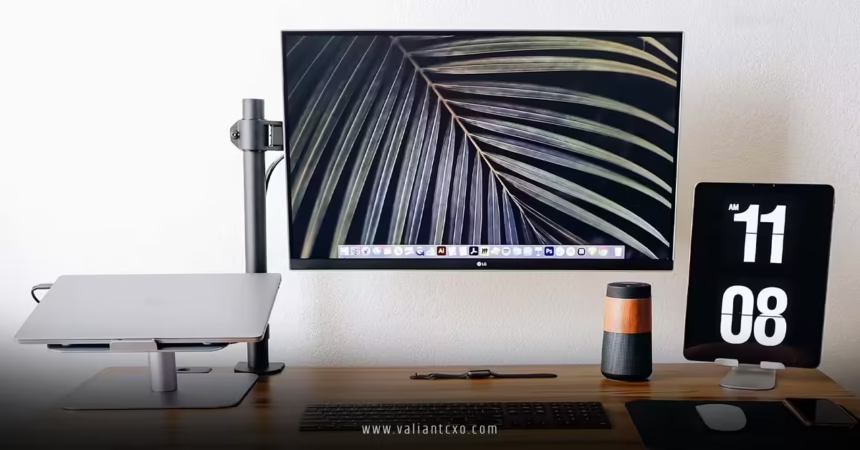How to create an organized digital workspace for productivity is a question that resonates with anyone drowning in digital clutter or struggling to stay focused. Picture your digital workspace as a desk: if it’s piled high with papers, coffee cups, and random trinkets, you’re not going to get much done. A messy digital environment—scattered files, endless browser tabs, and a chaotic inbox—can sap your energy just as much. In this article, I’ll walk you through practical, actionable steps to build a digital workspace that sparks productivity, reduces stress, and feels like a breath of fresh air. With over 2000 words of insights, let’s dive into creating a system that works for you.
Why an Organized Digital Workspace Matters
Ever sat down to work, only to spend 20 minutes hunting for a file or untangling a mess of browser tabs? A disorganized digital workspace isn’t just annoying—it’s a productivity killer. Studies, like one from Harvard Business Review, show that clutter, even digital, increases stress and reduces focus. When your files are scattered, notifications ping endlessly, and your desktop looks like a war zone, your brain has to work overtime just to process the chaos.
Creating an organized digital workspace for productivity is about reclaiming control. It’s like giving your brain a clear runway to take off and soar through tasks. Whether you’re a freelancer, a student, or a corporate warrior, an organized digital setup saves time, boosts efficiency, and makes work feel less like a slog. Ready to get started? Let’s break it down.
Step 1: Declutter Your Digital Environment
Clear Your Desktop
Your computer desktop is the front door to your digital workspace. If it’s littered with random screenshots, old PDFs, and shortcut icons, it’s like walking into a house with junk piled in the entryway. To create an organized digital workspace for productivity, start by clearing your desktop. Keep only the essentials—maybe a shortcut to your most-used folder or app. Everything else? Delete it or move it to a designated folder.
Here’s a quick trick: create a temporary “Sort Later” folder for anything you’re unsure about. Set a reminder to tackle it in a week. Chances are, you won’t miss most of it. A clean desktop isn’t just visually soothing; it signals to your brain that it’s time to focus.
Organize Your Files and Folders
Next, tackle your file system. A chaotic folder structure is like a library with books tossed randomly on shelves. To create an organized digital workspace for productivity, build a logical folder hierarchy. Start with broad categories like “Work,” “Personal,” “Projects,” and “Archives.” Within each, create subfolders for specific tasks or clients. For example:
- Work > Client Projects > [Client Name] > 2025
- Personal > Finances > Taxes > 2025
- Projects > Blog > Drafts
Use clear, descriptive names and stick to a consistent naming convention, like “YYYY-MM-DD” for dates. This makes searching a breeze. Tools like Dropbox can sync your folders across devices, ensuring you’re always organized, whether you’re on your laptop or phone.
Purge Unnecessary Files
Be ruthless with old files. That 2018 presentation you haven’t opened in years? Trash it. Duplicate files? Gone. To create an organized digital workspace for productivity, run a decluttering session every few months. Use built-in tools like Windows Storage Sense or Mac’s Optimize Storage to identify space hogs. Freeing up space isn’t just about storage—it’s about mental clarity.
Step 2: Streamline Your Tools and Apps
Choose the Right Productivity Tools
Your digital workspace is only as good as the tools you use. But here’s the catch: too many apps can create chaos instead of calm. To create an organized digital workspace for productivity, pick tools that align with your workflow. For task management, apps like Trello or Todoist are great for visualizing tasks. For note-taking, Notion or Evernote can keep ideas organized. The key? Choose one tool per purpose and stick with it.
Think of your tools like kitchen utensils: you don’t need five spatulas. One good one does the job. Test a tool for a week, and if it doesn’t click, move on. Consistency is king.
Organize Your App Layout
Ever opened your phone or computer and felt overwhelmed by a sea of app icons? To create an organized digital workspace for productivity, group apps logically. On your phone, create folders like “Work,” “Communication,” and “Utilities.” On your computer, pin your most-used apps to the dock or taskbar and hide the rest. This reduces visual noise and makes accessing tools intuitive.
Pro tip: Use a launcher like Alfred (Mac) or PowerToys (Windows) to quickly find apps without digging through menus. It’s like having a personal assistant who knows exactly where everything is.
Minimize Notifications
Notifications are the digital equivalent of someone tapping your shoulder every five minutes. To create an organized digital workspace for productivity, turn off non-essential notifications. On your phone, enable “Do Not Disturb” during work hours, allowing only critical alerts. On your computer, mute Slack pings or email pop-ups. Studies show multitasking reduces productivity by up to 40%—notifications are a big culprit.
Step 3: Master Your Email and Communication
Tame Your Inbox
An overflowing inbox is a productivity vampire. To create an organized digital workspace for productivity, aim for “inbox zero” (or close to it). Start by unsubscribing from newsletters you never read—services like Unroll.Me can help. Then, set up filters to automatically sort emails into folders like “To Action,” “Waiting,” or “Reference.” Gmail and Outlook both offer robust filtering options.
For emails requiring action, use the “two-minute rule”: if it takes less than two minutes, do it now. Otherwise, schedule it or delegate it. A clean inbox frees your mind to focus on what matters.
Streamline Communication Channels
If you’re juggling Slack, Teams, email, and texts, you’re probably exhausted. To create an organized digital workspace for productivity, consolidate communication where possible. For example, use Slack for team chats and email for external communication. Set clear boundaries—like checking messages only at specific times—to avoid constant interruptions. It’s like setting office hours for your digital life.
Step 4: Optimize Your Browser for Focus
Manage Tabs and Bookmarks
Browser tabs are the digital equivalent of sticky notes plastered everywhere. To create an organized digital workspace for productivity, keep open tabs to a minimum—ideally under five. Use extensions like OneTab to save groups of tabs for later. For bookmarks, organize them into folders like “Research,” “Tools,” or “Inspiration.” A tidy browser feels like a clean slate for your brain.
Use Productivity Extensions
Browser extensions can supercharge your workflow. To create an organized digital workspace for productivity, try tools like Momentum for a distraction-free start page or Grammarly for polished writing. Ad blockers like uBlock Origin reduce distractions from pop-ups. Just don’t go overboard—too many extensions can slow your browser down.
Step 5: Create a Routine for Maintenance
Schedule Regular Cleanups
An organized digital workspace isn’t a one-and-done deal. To create an organized digital workspace for productivity, schedule monthly cleanups. Set aside 30 minutes to delete old files, update passwords, and review your tools. It’s like tidying your room—regular maintenance keeps chaos at bay.
Back Up Your Data
Nothing derails productivity like losing important files. To create an organized digital workspace for productivity, back up your data regularly. Use cloud services like Google Drive or external drives for redundancy. Automate backups where possible to avoid human error. Think of it as an insurance policy for your digital life.
Reflect and Adjust
Every few months, assess your setup. Are your tools still serving you? Is your folder structure working? To create an organized digital workspace for productivity, be willing to tweak your system. Flexibility ensures your workspace evolves with your needs.
Step 6: Personalize Your Workspace for Inspiration
Customize Your Interface
A sterile digital workspace can feel uninspiring. To create an organized digital workspace for productivity, add personal touches. Set a calming desktop wallpaper or use a color scheme that energizes you. Small tweaks, like organizing your dock with colorful icons, can make your workspace feel uniquely yours.
Create Focus Zones
Designate specific devices or profiles for different tasks. For example, use one browser profile for work and another for personal browsing. This separation helps your brain switch gears, making it easier to focus. It’s like having a home office and a cozy living room—each space has a purpose.
Conclusion
How to create an organized digital workspace for productivity isn’t just about tidying files or closing tabs—it’s about designing a system that supports your goals and frees your mind to do its best work. By decluttering your desktop, streamlining tools, taming your inbox, optimizing your browser, maintaining routines, and adding personal flair, you can transform your digital environment into a productivity powerhouse. Start small, experiment with what works, and watch your efficiency soar. Why settle for digital chaos when you can create a workspace that feels like a well-oiled machine?
FAQs
1. Why is it important to create an organized digital workspace for productivity?
An organized digital workspace reduces stress, saves time, and boosts focus by eliminating clutter and distractions, allowing you to work more efficiently.
2. How often should I declutter my digital workspace?
To create an organized digital workspace for productivity, aim to declutter monthly. Regular cleanups prevent chaos from creeping back in.
3. What are the best tools to create an organized digital workspace for productivity?
Tools like Trello for task management, Notion for notes, and Dropbox for file storage are great choices, depending on your workflow needs.
4. How can I manage notifications to stay productive?
Turn off non-essential notifications and use “Do Not Disturb” modes during work hours to create an organized digital workspace for productivity.
5. Can personalizing my digital workspace really improve productivity?
Yes! A customized interface, like a motivating wallpaper, can make your workspace inviting, supporting your efforts to create an organized digital workspace for productivity.
Click Here:valiantcxo.com


